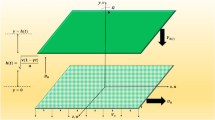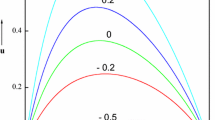Abstract
The influence of nonlinear thermal radiation on the flow of a viscous fluid between two infinite parallel plates is investigated. The lower plate is solid, fixed and heated, while the upper is porous and capable of moving toward or away from the lower plate. The effects of nonlinear thermal radiation are incorporated in the energy equation by using Rosseland approximation. The similarity transformations have been used to obtain a system of ordinary differential equations. A finite element algorithm, known as Galerkin method, has been employed to obtain the solution of the resulting system of differential equations. It is observed that the radiation parameter Rd increases the temperature of the fluid in all the cases considered. Same is the case with temperature ratio parameter θ w . The influence of the concerned parameters on the local rate of heat transfer is also displayed with the help of graphs.











Similar content being viewed by others
References
Berman AS (1953) Laminar flow in channels with porous walls. J Appl Phys 24:1232–1235
Dauenhauer EC, Majdalani J (1999) Unsteady flows in semi-infinite expanding channels with wall injection. In: 30th AIAA fluid dynamics conference, Norfolk
Majdalani J, Zhou C, Dawson CA (2002) Two-dimensional viscous flow between slowly expanding or contracting walls with weak permeability. J Biomech 35:1399–1403
Xinhui S, Liancun Z, Xinxin Z, Jianhong Y (2011) Homotopy analysis method for the heat transfer in a asymmetric. Appl Math Model 35:4321–4329
Ahmed N, Khan U, Zaidi ZA, Jan SU, Waheed A, Mohyud-Din ST (2014) MHD flow of an incompressible fluid through porous medium between dilating and squeezing permeable walls. J Porous Med 17(10):861–867
Xinhui S, Liancuna Z, Xinxin Z, Xinyi S, Min L (2014) Asymmetric viscoelastic flow through a porous channel with expanding or contracting walls: a model for transport of biological fluids through vessels. Comput Methods Biomech Biomedical Eng 17(6):623–631
Ahmed N, Mohyud-Din ST, Hassan SM (2016) Flow and heat transfer of nanofluid in an asymmetric channel with expanding and contracting walls suspended by carbon nanotubes: a numerical investigation. Aerosp Sci Technol 48:53–60
Ciancio A (2007) Analysis of time series with wavelets. Int J Wavelets Multiresolut Inf Process 5(2):241–556
Ciancio V, Ciancio A, Farsaci F (2008) On general properties of phenomenological and state coefficients for isotropic viscoanelastic media. Phys B 403(18):3221–3227
Ciancio A, Quartarone A (2013) A hybrid model for tumor-immune competition. UPB Sci Bull Ser A 75(4):125–136
Sheikholeslamia M, Ellahi R (2015) Three dimensional mesoscopic simulation of magnetic field effect on natural convection of nanofluid. Int J Heat Mass Transf 89:799–808
Ellahi R, Hassan M, Zeeshan A (2015) Study on magnetohydrodynamic nanofluid by means of single and multi-walled carbon nanotubes suspended in a salt water solution. IEEE Trans Nanotechnol 14(4):726–734
Kandelousi MS, Ellahi R (2015) Simulation of ferrofluid flow for magnetic drug targeting using the lattice Boltzmann method. Z Naturforsch A 70(2):115–124
Haq RU, Khan ZH, Noor NFM (2016) Numerical simulation of water base magnetite nanoparticles between two parallel disks. Adv Powder Technol. doi:10.1016/j.apt.2016.05.020
Hussain ST, Haq RU, Noor NFM, Nadeem S (2015) Non-linear radiation effects in mixed convection stagnation point flow along a vertically stretching surface. Int J Chem Reactor Eng. doi:10.1515/ijcre-2015-0177
Ciancio A, Ciancio V, Francesco F (2007) Wave propagation in media obeying a thermoviscoanelastic model. UPB Sci Bull Ser A 69:69–81
Rashidi MM, Pour SM, Abbasbandy S (2011) Analytic approximate solutions for heat transfer of a micropolar fluid through a porous medium with radiation. Commun Nonlinear Sci Numer Simul 16(4):1874–1889
Noor NFM, Abbasbandy S, Hashim I (2012) Heat and mass transfer of thermophoretic MHD flow over an inclined radiate isothermal permeable surface in the presence of heat source/sink. Int J Heat Mass Transf 55(7–8):2122–2128
Haq RU, Nadeem S, Akbar NS, Khan ZH (2015) Buoyancy and radiation effect on stagnation point flow of micropolar nanofluid along a vertically convective stretching surface. IEEE Trans Nanotechnol 14(1):42–50
Mohyud-Din ST, Khan SI (2016) Nonlinear radiation effects on squeezing flow of a Casson fluid between parallel disks. Aerosp Sci Technol 48:186–192
Khan U, Ahmed N, Mohyud-Din ST, Bin-Mohsin B (2016) Nonlinear radiation effects on MHD flow of nanofluid over a nonlinearly stretching/shrinking wedge. Neural Comput Appl 1–10. doi:10.1007/s00521-016-2187-x
Rybick GB, Lightman AP (1985) Radiative processes in astrophysics. Wiley-VCH, Weinheim
Goto M, Uchida S (1990) Unsteady flow in a semi-infinite contracting expanding pipe with a porous wall. In: Proceeding of the 40th Japan national congress applied mechanics NCTAM-40, Tokyo
Boutros ZY, Mina B, Abd-el-Malek B (2007) Lie-group method solution for two-dimensional viscous flow between slowly expanding or contracting walls with weak permeability. Appl Math Model 31:1092–1108
Acknowledgments
The authors extend their appreciation to the Deanship of Scientific Research at King Saud University for funding this work through research Group No. RG-1437-019.
Author information
Authors and Affiliations
Corresponding author
Ethics declarations
Conflict of interest
The authors declare that there is no conflict of interest regarding the publication of this article.
Rights and permissions
About this article
Cite this article
Ahmed, N., Khan, U., Mohyud-Din, S.T. et al. A finite element investigation of the flow of a Newtonian fluid in dilating and squeezing porous channel under the influence of nonlinear thermal radiation. Neural Comput & Applic 29, 501–508 (2018). https://doi.org/10.1007/s00521-016-2463-9
Received:
Accepted:
Published:
Issue Date:
DOI: https://doi.org/10.1007/s00521-016-2463-9




